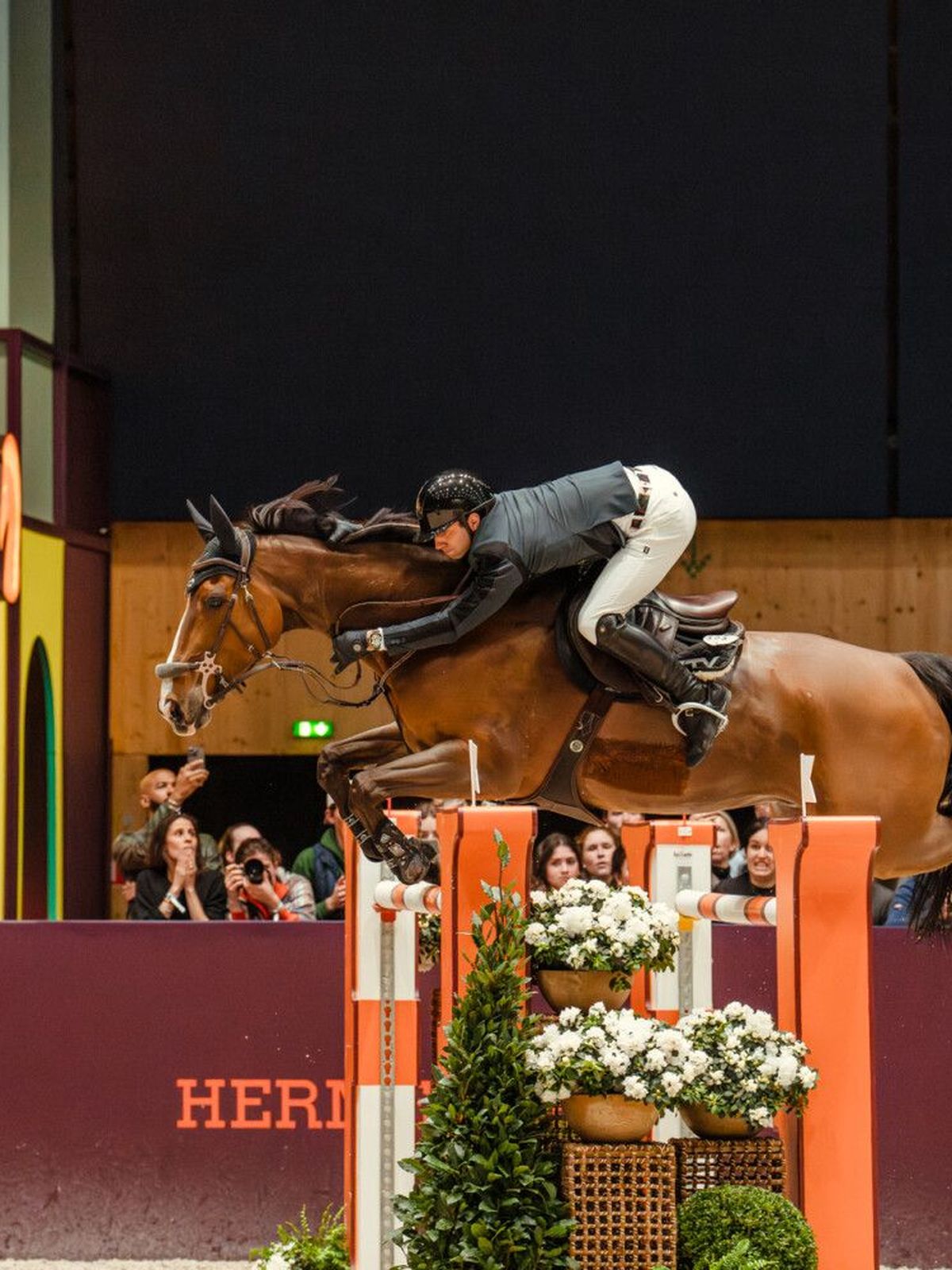Reflecting on the 14th edition of the annual show-jumping competition Saut Hermès, Hermès’ director of equestrian métier talks us through the house's inextricable bond with the horse – and how it lives on today
Brimming with anticipation for the upcoming XXXII Olympic Games, Paris was recently given a glimpse of the prestigious sportsmanship that will descend on the capital in July. The architecturally striking Grand Palais Éphémère – set to host a variety of Olympic competitions, including fencing and taekwondo – was transformed into an equestrian extravaganza for the Saut Hermès: the annual spring event hosted by the French Maison to spotlight the elite of international show jumping.
Across the Éphémère’s sand-covered arena were splashes of Hermès’ orange. Even the jumps were a nod to the brand's DNA: some as illustrated reproductions of the façade of 24 Rue du Faubourg Saint-Hororé (home to the house's historic saddle workshop), some simply forming the classic Hermès H. Once the competition was underway, horses and their riders – more than 75 from 20 different countries – glided over the obstacles with elegance and unswerving precision. The weekend culminated with 32-year-old Frenchman Julien Anquetin securing victory in the Grand Prix Hermès, which he described as his “finest career victory.”

Grand Prix winner Julien Anquetin and horse Blood Diamond du Pont at the Saut Hermès 2024. Photo: Christophe Tanière

Photo: Christophe Tanière
But it’s about more than just the competition, says Hermès’ director of equestrian métier Chloé Nobécourt. “For me, it is a family reunion! We welcome incredible riders, our partner riders, our teams, our craftsmen, clients, press, and the public – all passionate about the horse,” Nobécourt says. Saut Hermès is an opportunity to celebrate the horse and the equestrian world, just a few kilometres from our Faubourg saddlery workshop, amongst so many horse lovers.”
As Nobécourt references, Jean-Louis Dumas (former Hermès CEO credited with revolutionising the house in the 1970s) is quoted as saying, “At Hermes, the horse is our first client.” It’s a statement that holds true when traced back to the brand’s beginnings, with the first Hermès harnesses dating back to 1837 – designed foremost to be comfortable for the horse and reveal its beauty, in a way that was “very light and refined, in contrast to heavily-decorated propositions at the time,” Nobécourt says. “Comfort of the horse and the rider is still paramount to use, which is why all of our saddles are made to measure for both of them,” she adds. “Hermès has also become renowned for its unmatched quality in terms of know-how and materials.”

Photo: Jessica Rodrigues
The making of a Hermès saddle is a meticulous process. Each is handmade by one craftsman from beginning to end, taking around a week to complete. One of the Maison’s stand-out techniques is its ‘point sellier’ (saddle stitching), which sees the leathers sewn with two needles and a single linen thread. This is utilised alongside astiquage (the waxy finish on the seams), abacarage (the slicing or splitting of leather into thin layers) and semences tapissières (the completion of the saddle’s construction with nails).
There is the rider who will share his feelings to the saddle expert. The saddle expert is the eyes and the ears of the craftsman, and the craftsmans is the hands that will bring the saddle to life.
Chloé Nobécourt, Hermès’ director of equestrian métier

Hermès’ director of equestrian métier Chloé Nobécourt.
Nobécourt describes the saddle-making journey as a convergence of three actors with three perspectives. “There is the rider who will share his feelings with the saddle expert. The saddle expert is the eyes and the ears of the craftsman, and the craftsman is the hands that will bring the saddle to life,” she says. While all three are crucial, Nobécourt pinpoints the central importance of the saddle expert’s “eyes and ears” role. “After helping the rider to choose the appropriate model, the expert observes the horse and takes its measurements,” she explains. “They can use a tool taking 99 points of measurement on the horseback to send to the workshop. It is as if we could bring the horse itself to the craftsman!”
Related: Jane Birkin on the Hermès Birkin: How fashion’s most iconic handbag was first sketched on a sickbag

Photo: Jessica Rodrigues

Photo: Jessica Rodrigues
Come July, the world’s eyes will join horse enthusiasts with the broadcast of Olympic equestrian competitions – and Scandinavia will have a strong presence, with the likes of Sweden’s Henrik von Ackerman and Denmark’s Carina Cassøe Krüth pitted for success amongst the national team formations. Just as the Olympics hype will give a boost to the equestrian world, the endorsement from the very best riders for Hermès saddles and bridlery has seen demand rising, Nobécourt shares. “In addition to our historic workshop within 24 Faubourg Saint-Honoré, we have inaugurated a new saddlery and bridlery workshop in Normandy at the Maroquinerie de Louviers last year. This allows our craftsmen to transmit their know-how to the next generation and to ensure that we can meet the demand,” she says.
The horse is so deeply ingrained in Hermès design language that it’s unavoidable. Whether it’s the Picotin Lock bag with a bucket shape inspired by a horse’s feedbag, the Verrou clutch whose closures reference the bolts on a stable door, or the coveted leather Rodeo charm, the reins that Nobécourt holds in the equestrian métier will continue to steer the house forward.